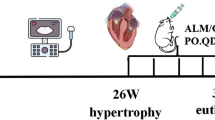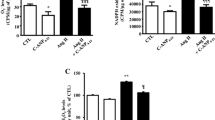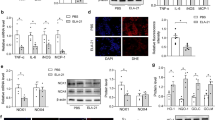Abstract
Asiatic acid, a triterpenoid compound derived from Centella asiatica, has been demonstrated to have antioxidant and anti-inflammatory effects. The present study evaluated the effects of asiatic acid on hemodynamic alterations, renin-angiotensin system (RAS), oxidative stress, and inflammation in 2K-1C hypertensive rats. Renovascular hypertension was induced in male Sprague-Dawley rats and treated with vehicle, asiatic acid (30 mg/kg/day), or captopril (5 mg/kg/day) for 4 weeks. We observed that 2K-1C hypertensive rats exhibited hemodynamic alterations such as high blood pressure, heart rate, hindlimb vascular resistance, and low hindlimb blood flow. Signs of RAS activation, such as increased plasma angiotensin II and serum angiotensin-converting enzyme activity, enhanced AT1R protein expression, and suppressed AT2R expression was observed in 2K-1C hypertensive rats. Overproduction of vascular superoxide, high levels of plasma MDA, low levels of plasma nitric oxide metabolites (NOx), and upregulation of gp91phox protein expression were observed in hypertensive rats. Furthermore, inflammation was observed in hypertensive rats, as evidenced by increased plasma TNF-α, NF-κB, and phospho-NF-κB protein expression. Asiatic acid or captopril alleviated hemodynamic alterations, RAS activation, oxidative stress, and inflammation in 2K-1C hypertensive rats. These findings indicate that asiatic acid is an antihypertensive agent that ameliorates hemodynamic alterations in 2K-1C hypertensive rats. This effect may involve one or both of the following mechanisms: the direct effect of asiatic acid on RAS activation, oxidative stress and inflammation, and/or asiatic acid acting as an ACE inhibitor agent to inhibit the Ang II-AT1R-NADPH oxidase-NF-κB pathway.







Similar content being viewed by others
References
Bautista LE, Vera LM, Arenas IA, Gamarra G (2005) Independent association between inflammatory markers (C-reactive protein, interleukin-6, and TNF-alpha) and essential hypertension. J Hum Hypertens 19:149–154. doi:10.1038/sj.jhh.1001785
Boonla O, Kukongviriyapan U, Pakdeechote P, Kukongviriyapan V, Pannangpetch P, Prachaney P, Greenwald SE (2014) Curcumin improves endothelial dysfunction and vascular remodeling in 2K-1C hypertensive rats by raising nitric oxide availability and reducing oxidative stress. Nitric Oxide 42:44–53. doi:10.1016/j.niox.2014.09.001
Boonla O, Kukongviriyapan U, Pakdeechote P, Kukongviriyapan V, Pannangpetch P, Thawornchinsombut S (2015) Peptides-derived from Thai Rice bran improves endothelial function in 2K-1C renovascular hypertensive rats. Nutrients 7:5783–5799. doi:10.3390/nu7075252nu7075252
Browatzki M et al (2005) Angiotensin II stimulates matrix metalloproteinase secretion in human vascular smooth muscle cells via nuclear factor-kappaB and activator protein 1 in a redox-sensitive manner. J Vasc Res 42:415–423. doi:10.1159/000087451
Bunbupha S, Pakdeechote P, Kukongviriyapan U, Prachaney P, Kukongviriyapan V (2014) Asiatic acid reduces blood pressure by enhancing nitric oxide bioavailability with modulation of eNOS and p47phox expression in L-NAME-induced hypertensive rats. Phytother Res 28:1506–1512. doi:10.1002/ptr.5156
Bunbupha S, Prachaney P, Kukongviriyapan U, Kukongviriyapan V, Welbat JU, Pakdeechote P (2015) Asiatic acid alleviates cardiovascular remodeling in rats with L-NAME-induced hypertension. Clin Exp Pharmacol Physiol. doi:10.1111/1440-1681.12472
Carey RM (2016) Update on angiotensin AT2 receptors. Curr Opin Nephrol Hypertens. doi:10.1097/MNH.0000000000000304
Cau SB, Guimaraes DA, Rizzi E, Ceron CS, Gerlach RF, Tanus-Santos JE (2015) The nuclear factor kappaB inhibitor pyrrolidine dithiocarbamate prevents cardiac remodelling and matrix metalloproteinase-2 up-regulation in renovascular hypertension basic. Clin Pharmacol Toxicol 117:234–241. doi:10.1111/bcpt.12400
da Costa CA et al (2012) Euterpe Oleracea Mart.-derived polyphenols prevent endothelial dysfunction and vascular structural changes in renovascular hypertensive rats: role of oxidative stress. Naunyn Schmiedeberg's Arch Pharmacol 385:1199–1209. doi:10.1007/s00210-012-0798-z
Ferreri NR, Escalante BA, Zhao Y, An SJ, McGiff JC (1998) Angiotensin II induces TNF production by the thick ascending limb: functional implications. Am J Phys 274:F148–F155
Friedland J, Silverstein E (1976) A sensitive fluorimetric assay for serum angiotensin-converting enzyme. Am J Clin Pathol 66:416–424
Garrido AM, Griendling KK (2009) NADPH oxidases and angiotensin II receptor signaling. Mol Cell Endocrinol 302:148–158. doi:10.1016/j.mce.2008.11.003
Goldblatt H, Lynch J, Hanzal RF, Summerville WW (1934) Studies on experimental hypertension : I. The Production of Persistent Elevation of Systolic Blood Pressure by Means of Renal Ischemia. J Exp Med 59:347–379
Grafe M et al (1997) Angiotensin II-induced leukocyte adhesion on human coronary endothelial cells is mediated by E-selectin. Circ Res 81:804–811
Griendling KK, Minieri CA, Ollerenshaw JD, Alexander RW (1994) Angiotensin II stimulates NADH and NADPH oxidase activity in cultured vascular smooth muscle cells. Circ Res 74:1141–1148
Guo K, Lan CZ, Yu TT, Huang LL, Wang XH, Pan C, Gao S (2014) Effects of Xin-Ji-Er-Kang formula on 2K1C-induced hypertension and cardiovascular remodeling in rats. J Ethnopharmacol 155:1227–1235. doi:10.1016/j.jep.2014.07.006
Higuchi S, Ohtsu H, Suzuki H, Shirai H, Frank GD, Eguchi S (2007) Angiotensin II signal transduction through the AT1 receptor: novel insights into mechanisms and pathophysiology. Clin Sci (Lond) 112:417–428. doi:10.1042/CS20060342
Huang SS et al (2011) Antinociceptive activities and the mechanisms of anti-inflammation of asiatic Acid in mice. Evid Based Complement Alternat Med 2011:895857. doi:10.1155/2011/895857
Jew SS et al (2000) Structure-activity relationship study of asiatic acid derivatives against beta amyloid (a beta)-induced neurotoxicity. Bioorg Med Chem Lett 10:119–121
Johns EJ (2009) Inflammation: the underlying foe in renovascular hypertension? J Hypertens 27:1964–1965. doi:10.1097/HJH.0b013e328331a881
Jung O, Schreiber JG, Geiger H, Pedrazzini T, Busse R, Brandes RP (2004) gp91phox-containing NADPH oxidase mediates endothelial dysfunction in renovascular hypertension. Circulation 109:1795–1801. doi:10.1161/01.CIR.0000124223.00113.A4
Kalaivani P et al (2013) Cuminum cyminum, a dietary spice, attenuates hypertension via endothelial nitric oxide synthase and NO pathway in renovascular hypertensive rats. Clin Exp Hypertens 35:534–542. doi:10.3109/10641963.2013.764887
Kranzhofer R, Browatzki M, Schmidt J, Kubler W (1999a) Angiotensin II activates the proinflammatory transcription factor nuclear factor-kappaB in human monocytes. Biochem Biophys Res Commun 257:826–828. doi:10.1006/bbrc.1999.0543
Kranzhofer R, Schmidt J, Pfeiffer CA, Hagl S, Libby P, Kubler W (1999b) Angiotensin induces inflammatory activation of human vascular smooth muscle cells. Arterioscler Thromb Vasc Biol 19:1623–1629
Landmesser U, Harrison DG (2001) Oxidative stress and vascular damage in hypertension. Coron Artery Dis 12:455–461
Lewis RA, Baker KM, Ayers CR, Weaver BA, Lehman MR (1985) Captopril versus enalapril maleate: a comparison of antihypertensive and hormonal effects. J Cardiovasc Pharmacol 7(Suppl 1):S12–S15
Li JJ, Chen JL (2005) Inflammation may be a bridge connecting hypertension and atherosclerosis. Med Hypotheses 64:925–929. doi:10.1016/j.mehy.2004.10.016
Li J, Xie ZZ, Tang YB (2010) Genistein prevents myocardial hypertrophy in 2-kidney 1-clip renal hypertensive rats by restoring eNOS pathway. Pharmacology 86:240–248. doi:10.1159/000320457000320457
Luangaram S, Kukongviriyapan U, Pakdeechote P, Kukongviriyapan V, Pannangpetch P (2007) Protective effects of quercetin against phenylhydrazine-induced vascular dysfunction and oxidative stress in rats. Food Chem Toxicol 45:448–455. doi:10.1016/j.fct.2006.09.008
Mak IT, Freedman AM, Dickens BF, Weglicki WB (1990) Protective effects of sulfhydryl-containing angiotensin converting enzyme inhibitors against free radical injury in endothelial cells. Biochem Pharmacol 40:2169–2175
Maneesai P, Bunbupha S, Kukongviriyapan U, Prachaney P, Tangsucharit P, Kukongviriyapan V, Pakdeechote P (2016a) Asiatic acid attenuates renin-angiotensin system activation and improves vascular function in high-carbohydrate, high-fat diet fed rats. BMC Complement Altern Med 16:123. doi:10.1186/s12906-016-1100-6
Maneesai P et al (2016b) Synergistic antihypertensive effect of Carthamus tinctorius L. extract and captopril in L-NAME-induced hypertensive rats via restoration of eNOS and AT(1)R expression. Nutrients 8:122. doi:10.3390/nu8030122
Miguel-Carrasco JL, Zambrano S, Blanca AJ, Mate A, Vazquez CM (2010) Captopril reduces cardiac inflammatory markers in spontaneously hypertensive rats by inactivation of NF-kB. J Inflamm (Lond) 7:21. doi:10.1186/1476-9255-7-211476-9255-7-21
Montenegro MF et al (2010) Quercetin restores plasma nitrite and nitroso species levels in renovascular hypertension. Naunyn Schmiedeberg's Arch Pharmacol 382:293–301. doi:10.1007/s00210-010-0546-1
Moubarak M, Jabbour H, Smayra V, Chouery E, Saliba Y, Jebara V, Fares N (2012) Cardiorenal syndrome in hypertensive rats: microalbuminuria, inflammation and ventricular hypertrophy. Physiol Res 61:13–24
Ortego M, Bustos C, Hernandez-Presa MA, Tunon J, Diaz C, Hernandez G, Egido J (1999) Atorvastatin reduces NF-kappaB activation and chemokine expression in vascular smooth muscle cells and mononuclear cells. Atherosclerosis 147:253–261
Padia SH, Kemp BA, Howell NL, Fournie-Zaluski MC, Roques BP, Carey RM (2008) Conversion of renal angiotensin II to angiotensin III is critical for AT2 receptor-mediated natriuresis in rats. Hypertension 51:460–465. doi:10.1161/HYPERTENSIONAHA.107.103242
Pakdeechote P, Bunbupha S, Kukongviriyapan U, Prachaney P, Khrisanapant W, Kukongviriyapan V (2014) Asiatic acid alleviates hemodynamic and metabolic alterations via restoring eNOS/iNOS expression, oxidative stress, and inflammation in diet-induced metabolic syndrome rats. Nutrients 6:355–370. doi:10.3390/nu6010355
Park BM, Gao S, Cha SA, Kim SH (2015) Attenuation of renovascular hypertension by cyclooxygenase-2 inhibitor partly through ANP release. Peptides 69:1–8. doi:10.1016/j.peptides.2015.03.022
Ramachandran V, Saravanan R, Senthilraja P (2014) Antidiabetic and antihyperlipidemic activity of asiatic acid in diabetic rats, role of HMG CoA: in vivo and in silico approaches. Phytomedicine 21:–225, 232. doi:10.1016/j.phymed.2013.08.027
Rincon J et al (2015) Role of angiotensin II type 1 receptor on renal NAD(P)H oxidase, oxidative stress and inflammation in nitric oxide inhibition induced-hypertension. Life Sci 124:81–90. doi:10.1016/j.lfs.2015.01.005
Rioja I, Terencio MC, Ubeda A, Riguera R, Quintela JM, Alcaraz MJ (2002) A new ditriazine inhibitor of NF-kappaB modulates chronic inflammation and angiogenesis. Naunyn Schmiedeberg's Arch Pharmacol 365:357–364. doi:10.1007/s00210-002-0544-z
Santuzzi CH, Tiradentes RV, Mengal V, Claudio ER, Mauad H, Gouvea SA, Abreu GR (2015) Combined aliskiren and L-arginine treatment has antihypertensive effects and prevents vascular endothelial dysfunction in a model of renovascular hypertension Braz. J Med Biol Res 48:65–76
Squadrito GL, Pryor WA (1995) The formation of peroxynitrite in vivo from nitric oxide and superoxide. Chem Biol Interact 96:203–206
Umka Welbat J et al (2016) Asiatic acid prevents the deleterious effects of valproic acid on cognition and hippocampal cell proliferation and survival. Nutrients 18:8(5). doi:10.3390/nu8050303
Yin MC, Lin MC, Mong MC, Lin CY (2012) Bioavailability, distribution, and antioxidative effects of selected triterpenes in mice. J Agric Food Chem 60:7697–7701. doi:10.1021/jf302529x
Acknowledgments
This study was funded by grants from the Invitation Research Fund (IN58342, IN59145), Faculty of Medicine, Khon Kaen University and from Khon Kaen University (590050), Thailand and the Thailand Research Fund (RSA6080005). Putcharawipa Maneesai is financially supported by the Cardiovascular Research Group, Khon Kaen University, Thailand. We would like to acknowledge Dr. Justin Thomas Reese for editing this manuscript via the Publication Clinic, KKU, Thailand.
Author information
Authors and Affiliations
Corresponding author
Ethics declarations
Conflict of interest
The authors declare that they have no competing interest.
Rights and permissions
About this article
Cite this article
Maneesai, P., Bunbupha, S., Kukongviriyapan, U. et al. Effect of asiatic acid on the Ang II-AT1R-NADPH oxidase-NF-κB pathway in renovascular hypertensive rats. Naunyn-Schmiedeberg's Arch Pharmacol 390, 1073–1083 (2017). https://doi.org/10.1007/s00210-017-1408-x
Received:
Accepted:
Published:
Issue Date:
DOI: https://doi.org/10.1007/s00210-017-1408-x




